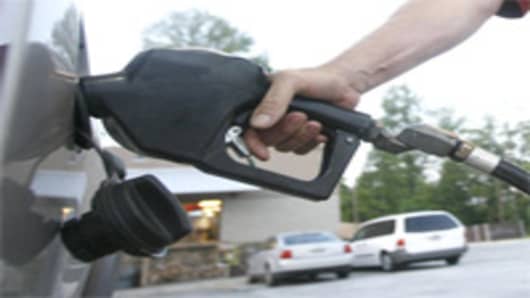It's been a hard couple weeks for U.S. drivers.
Over the last two weeks, the average price of regular unleaded gasoline has increased 18 cents to $3.69 a gallon. According to the EIA, drivers on the West Coast are getting the biggest sticker shock at the pump, paying an average of $3.90 for a gallon of regular unleaded gasoline. The Rocky Mountain region however is paying the least, at an average of $3.10 a gallon.
Drivers aren't the only group growing concerned as gas prices tick upwards. Most retailers and consumer discretionary businesses consider $4 gasolinethe tipping point, where consumers begin to pull back on their discretionary spending.
Michael Niemira, chief economist at the International Council of Shopping Centers, says a pullback in consumer spending is of particular concern right now. "The employment picture looks a little bit better, so the fact that we are layering on this worry on gasoline and inflation isn't a good situation as we're just now starting to see some momentum on the positive side of the economy."
According to Customer Growth Partners, U.S consumers begin to cut back on discretionary spending when their combined energy-related spending reaches 6 percent of total spending. Customer Growth Partners calculates right now 6.2 percent of total consumer spending is going to energy, up from 5.8 percent last quarter.
The beginning of June 2008 was the first time gas prices rose above $4 a gallon and energy-related spending hit 6 percent of total U.S consumer spending. From the time gas prices rose from $3 to $4, the S&P Retail Indexfell 11 percent and 10 of the components saw shares lose more than 13 percent.
Department storesSears and Macy's fared the worst, with shares down 36 percent and 30 percent, respectively.
And neitherDollar Treenor Family Dollarsaw boosts from consumers trading-down. Shares of Family Dollar fell 6 percent and shares of Dollar Tree fell 1 percent during the period from Nov. 5, 2007, to June 9, 2008, when the average price at the pump rose from $3 to $4 a gallon.
But some retailers — typically those that also sell gasoline — benefit when gas prices near $4 a gallon. Shares of retailers Costco and Walmart gained 8.5 percent and 32 percent, respectively.
In December 2010, gas prices again crossed $3, hitting near $4 five months later.
However, with the markets in rally mode, the S&P retail index rose nearly 6 percent from Dec. 27, 2010, to May 9, 2011.
Only 4 retailers in the index saw shares lose more than 11 percent. The hardest hit were Target and Urban Outfitters. Target shares fell nearly 17 percent and shares of Urban Outfitters lost 12 percent. Whereas Costco again saw shares gain, this time more than 11 percent, on a 14 percent increase in revenue during the period compared to the same two quarters the year prior.
While increasing gasoline prices don't typically have an immediate impact on the high-end consumer, Niemiera acknowledges over time there will be an indirect impact.
"If rising gasoline prices start to create a worry about the economy, profits affect stock prices and then you can have the impact on the high-end as well, so your luxury stores could be affected, but that’s an indirect effect," he said.
Right now, retailers are holding their breath, with the S&P Retail index outperforming the S&P 500 over the past two weeks even as average gasoline prices have gained 18 cents per gallon.
But, Niemiera notes the impact of higher gasoline prices isn't always immediate. "You have to see some sustained price rise before you see some reaction on the part of the consumer...if these prices continue to be a problem in the next four months, we could start to see some reductions in spending."
Questions? Comments? Email us at consumernation@cnbc.com. Follow Courtney Reagan on Twitter @CourtReagan.



